Email workflows are a marketer's secret weapon. They can help you:
-
Convert free trialers into loyal customers.
-
Turn subscribers into avid readers (and advocates).
-
Solve user problems, without them needing to contact support.
And much more…
Workflows will not only help boost your bottom line, they can help you save a ton of precious time.
In this post, I’m going to tell you exactly how you can use email workflows to grow your business.
%(tableofcontents)
Let’s get started…
What Is An Email Workflow?
An email workflow is a series of emails triggered by subscriber actions or data.
For example:
-
[Action] Send an email based on the action of a user joining your list; or
-
[Data] Send an email because a customer hasn’t purchased in 90 days
Each email workflow your business uses should have a goal attached to it, such as helping to convert trialers to customers or helping email subscribers to move through your funnel.
Here are eight email workflows you can use for your business:
8 Email Workflow Examples
1. Welcoming New Blog Subscribers
When someone subscribes to your blog, you want to make them feel welcome. This can be done with an email workflow.
A blog subscriber workflow should:
-
Thank the subscriber for joining your list.
-
Tell them what they can expect from your blog.
-
Share some links back to your content so they can dive in.
It’s also worth setting an expectation of how often you’ll email them so the subscriber knows when you’ll pop up in their inbox.
Here’s an example blog welcome email from Buffer. Upon subscribing to Buffer’s list, people receive the email below immediately:

Buffer then sends four emails in the next four days; each email highlights a specific piece of content.
Emails highlight the most popular posts on the blog, as well as high-converting posts with good chance of helping move email subscribers through the funnel to becoming customers.
Bonus: Advanced Welcome Email Strategies
Want to take your welcome emails to the next level? Watch Ilona explain how AppSumo uses segmented email workflows based on acquisition source:
2. Getting Started Workflow
When a customer signs up to your service or makes a purchase from your store, an email series is a great way to help them get started and learn how to get the most from their purchase.
For example, SEO software makers Ahrefs sends a four-email sequence to welcome new customers.
The first email provides new customers with an overview of the Ahrefs product and some guides to help them get started:
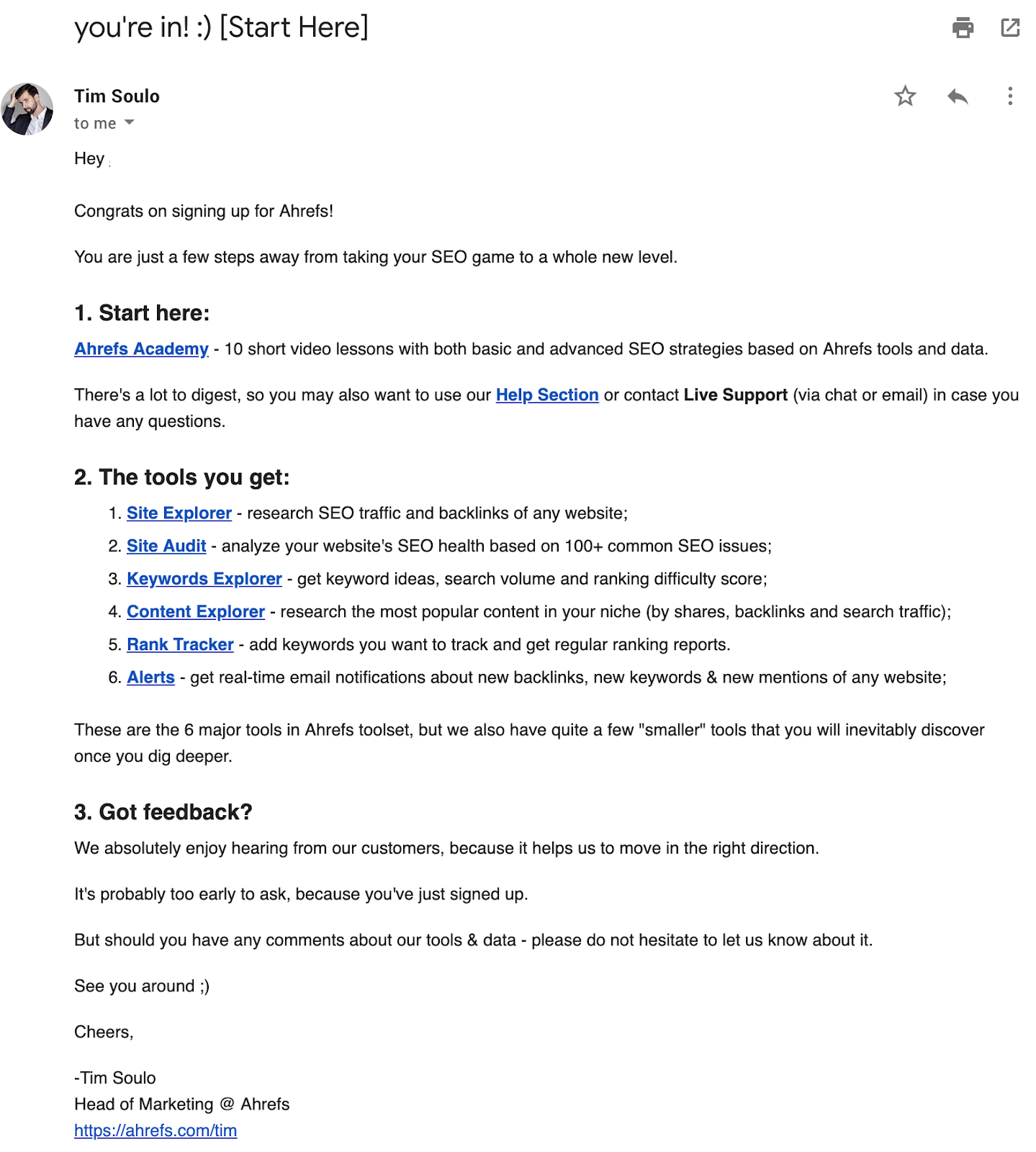
The next two emails share links to some of Ahrefs’ best guides on SEO:
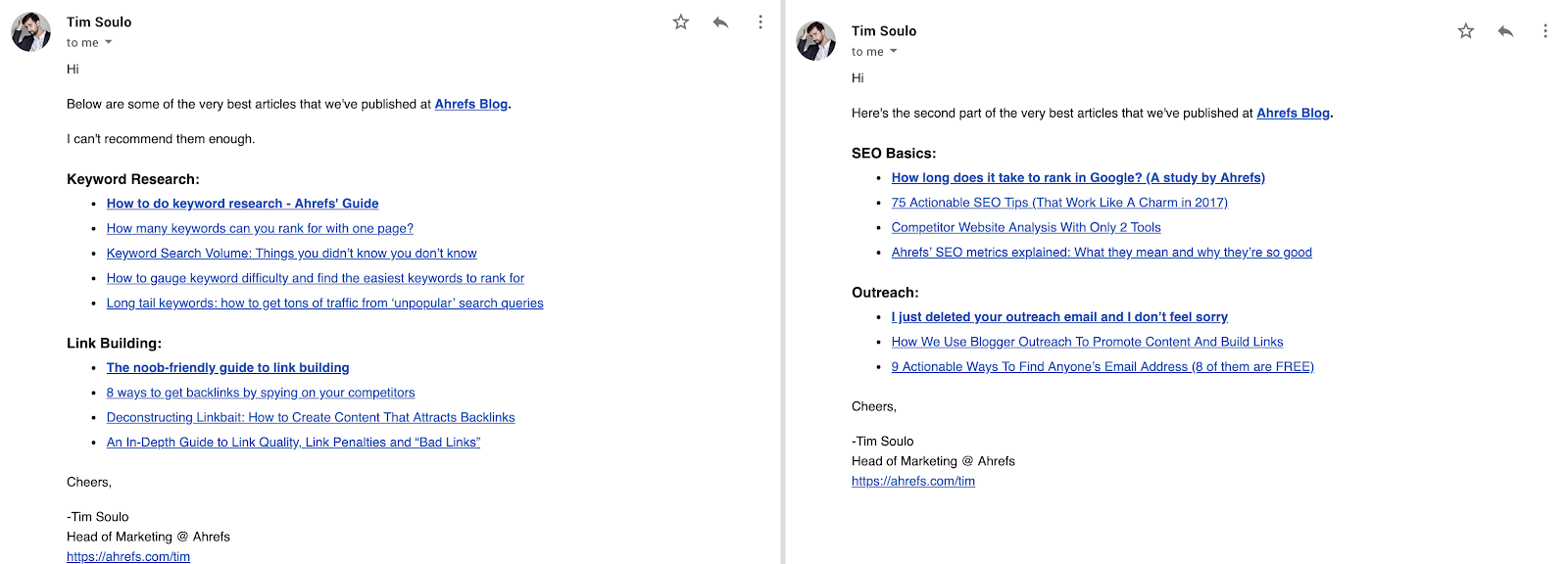
These guides often feature the Ahrefs product directly, so act as a reminder of the value the customers get from it:
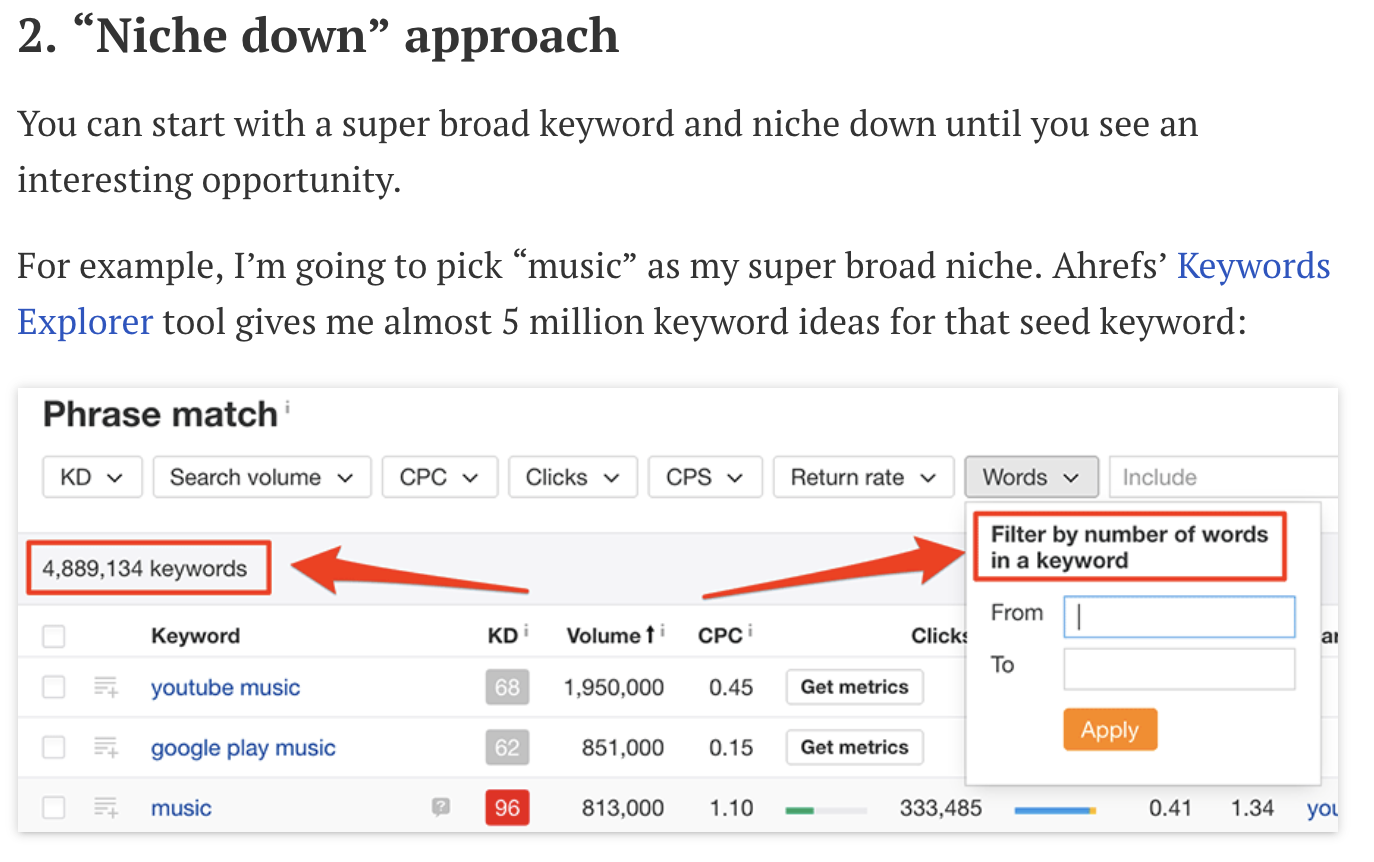
And the fourth email directs people to join a private Facebook Group for customers:
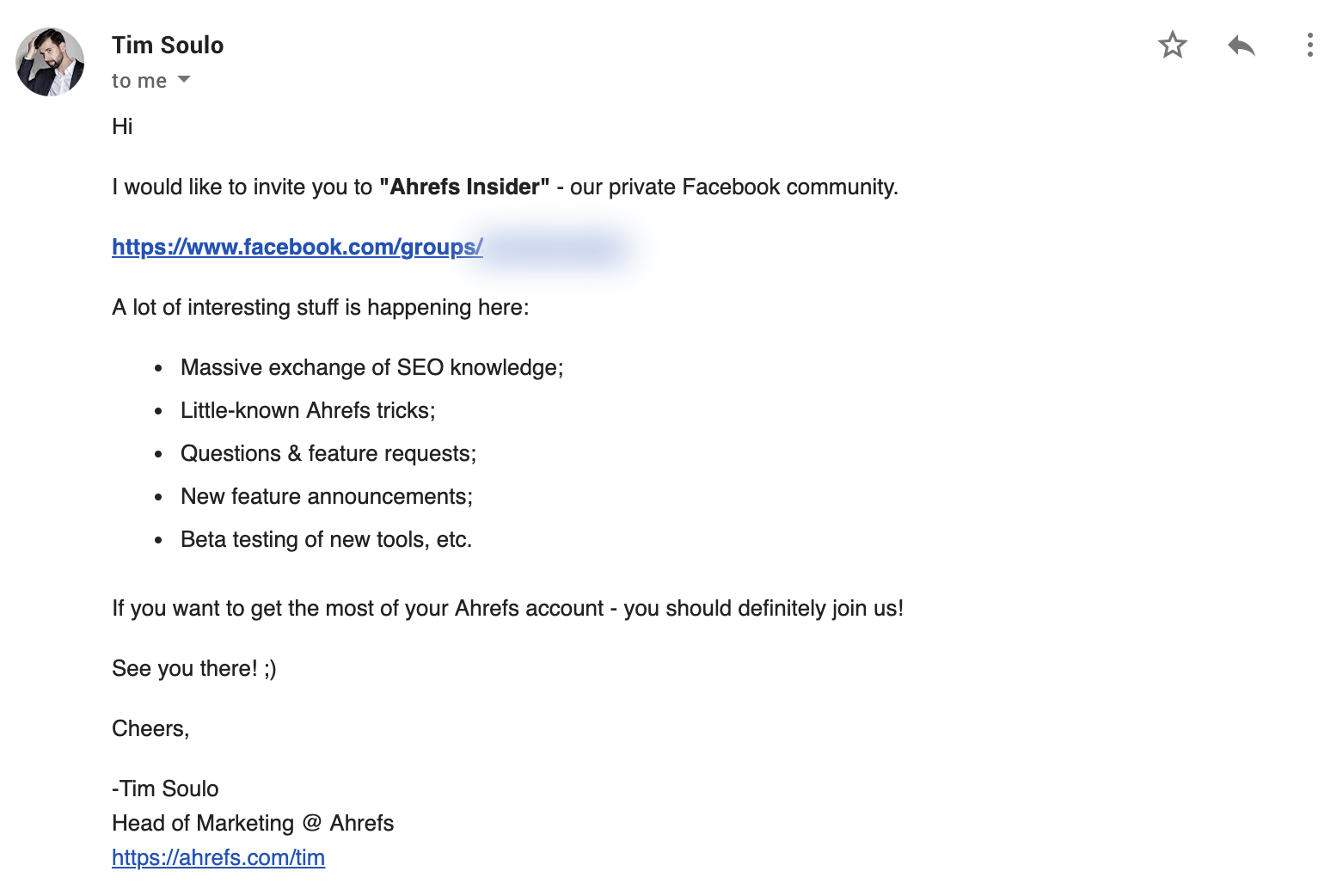
This is a great way to build a sense of community among customers and help people to get the most from your product.
When creating a "Getting Started" workflow for your business, think about:
-
The steps a new customer needs to take to find their "Aha" moment with your business (and how you can guide them toward that moment).
-
The first steps they need to take to get up and running.
-
The point of contact for your support team in case they run into any issues.
3. Lead-Nurturing Workflow
When you capture a new lead, they might not be ready to make a purchase right away. This is where a lead-nurturing workflow can help.
These emails gradually move new leads down your funnel. Initially, they might focus on more middle-of-the-funnel content to help leads to learn more about your business, then they’ll finish up with a bottom-of-the-funnel "ask" to encourage leads to convert.
This ask could be:
-
Taking a product trial.
-
Speaking to a sales specialist.
-
Making a purchase.
Here’s a quick example of the lead-nurturing workflow in action from Shopify Plus.
When someone signs up for one of Shopify’s lead magnets (example below), they join a short email workflow.
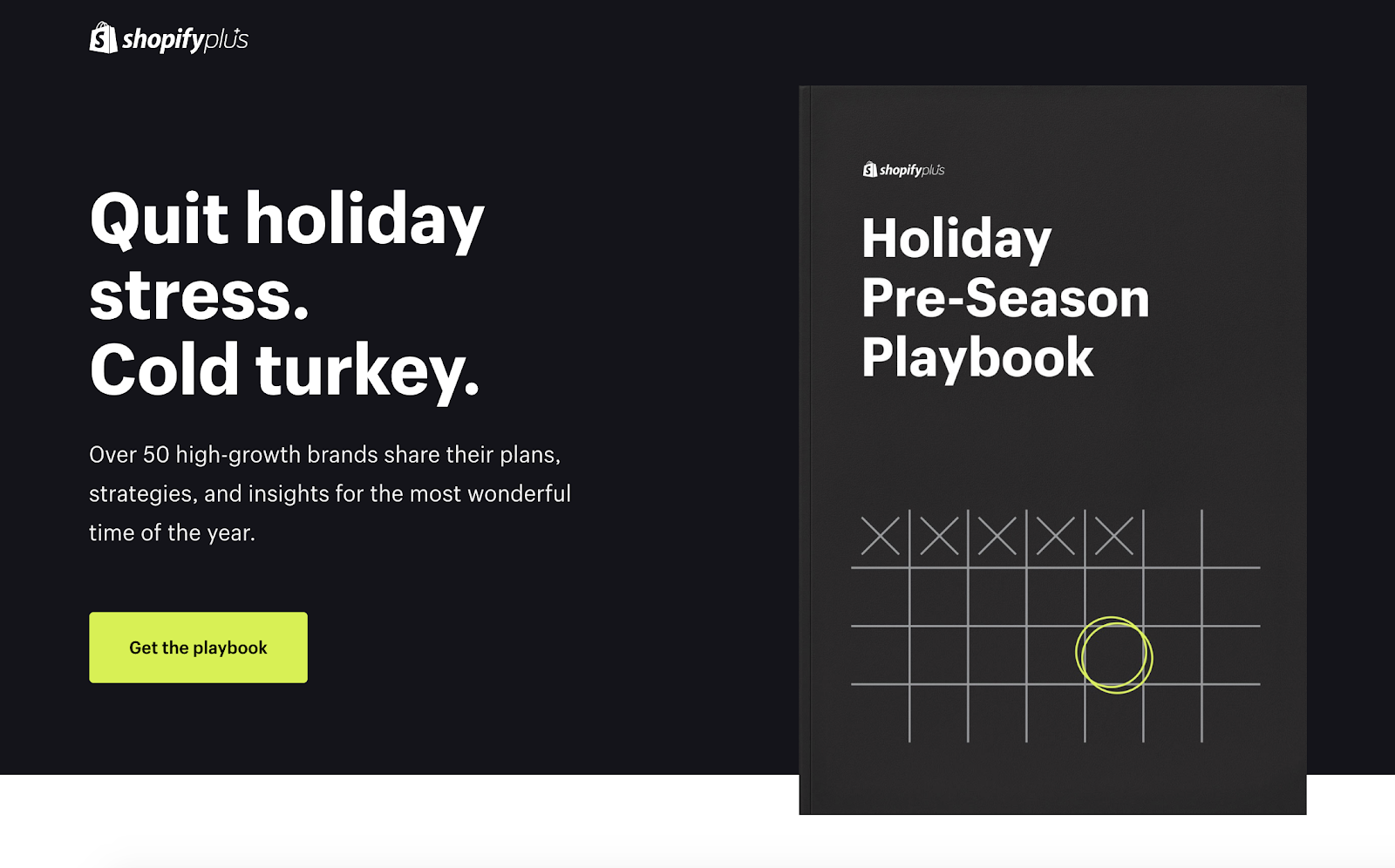
There are only two emails.
The first email delivers the lead magnet and provides an opportunity to connect with the Shopify Plus team to chat more about their solutions:

In the second email, Shopify asks whether you found everything you needed from the lead magnet. It then takes a direct-to-sale approach by encouraging the lead to learn more about Shopify Plus and book a time to talk with an expert:

Bonus: Notice how Shopify uses social proof by sharing some brands (MVMT, Kylie Cosmetics) that are already using Shopify Plus.
4. Sales Negotiation Workflow
Sometimes making a purchase takes negotiation, especially if your business is a marketplace specializing in trading between a product owner and consumer.
For example, when trying to buy a registered domain, a company like Uniregistry might handle negotiations between parties. One of the most effective ways to handle this negotiation is through an email workflow.
When you send an inquiry about a domain Uniregistry represents, you’re added to a workflow.
The first email introduces you to the broker for your chosen domain:
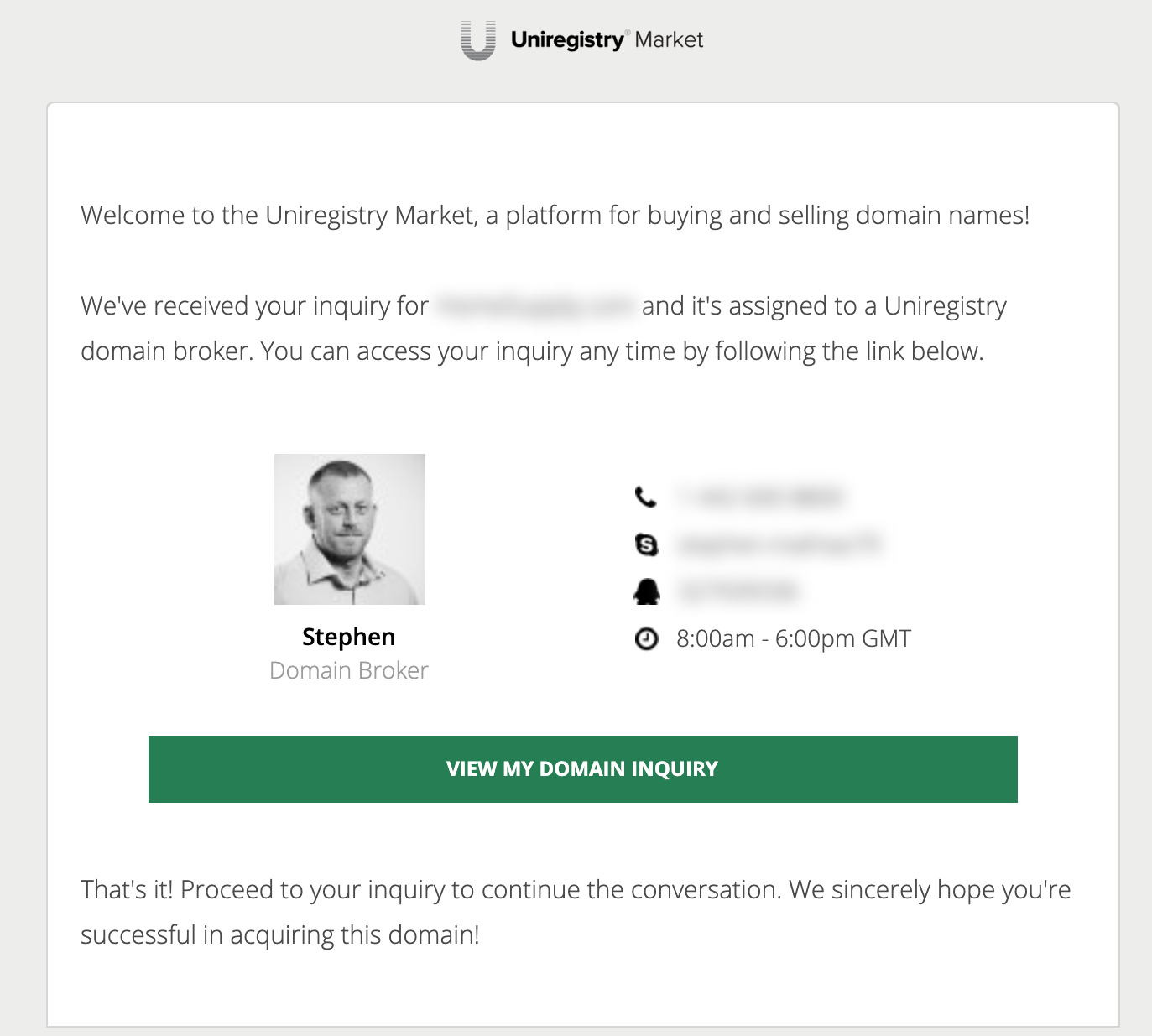
The second email is in plain text, and it follows up with a price for the domain. This email is sent three days after the original email:
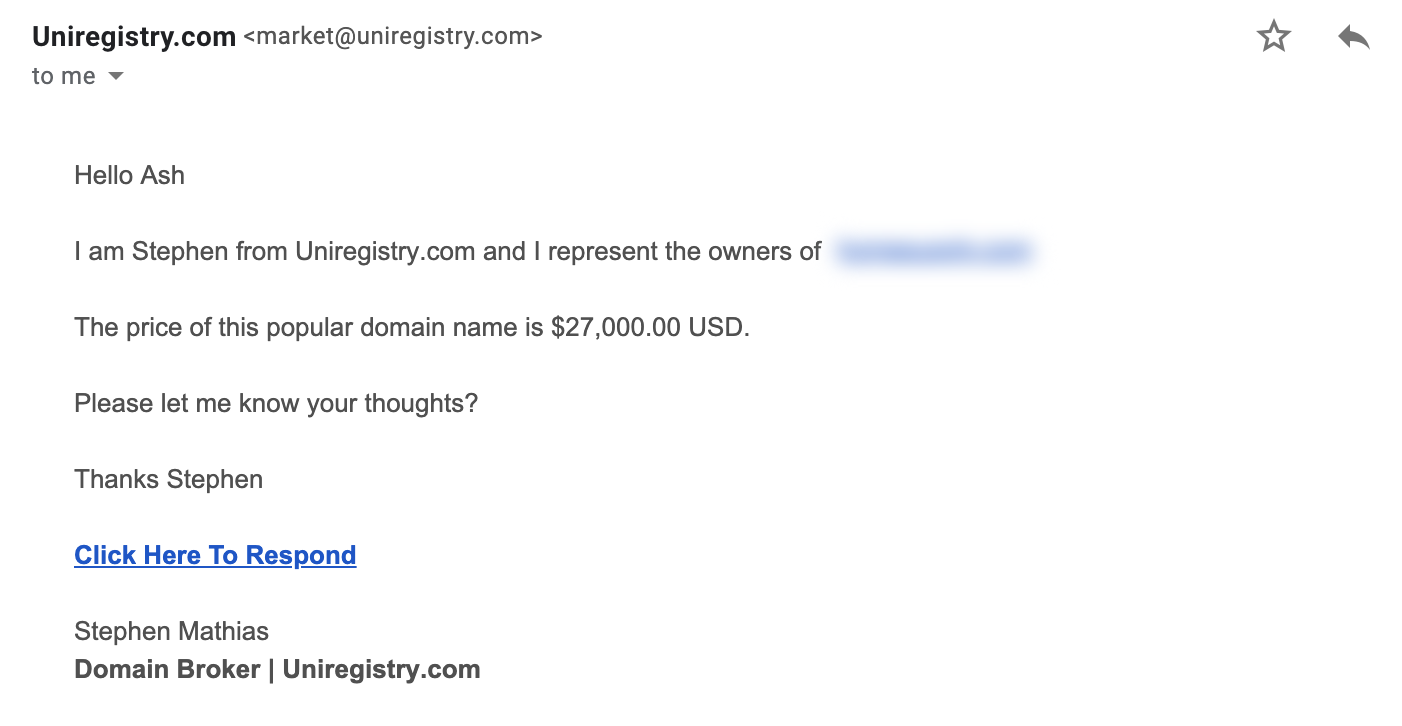
The third email is sent five days after the second email and encourages the recipient to share their proposed next step in the negotiation:

After this email the workflow continues for a couple more weeks if you don’t respond to any of the first three messages. The emails get more infrequent as time passes.
5. Fixing An Issue Workflow
No matter how great your processes and internal systems are, sometimes your customers will run into a problem.
This is especially common for subscription companies, and one of the most common issues is payment details expiring.
To fix this, Netflix turns to an email workflow.
The first email explains the issue, provides the customer with details on fixing it, and offers contact details if additional support is needed. This email is sent immediately after a payment has failed:

The second email is the sequence is triggered when the customer has updated their payment details:
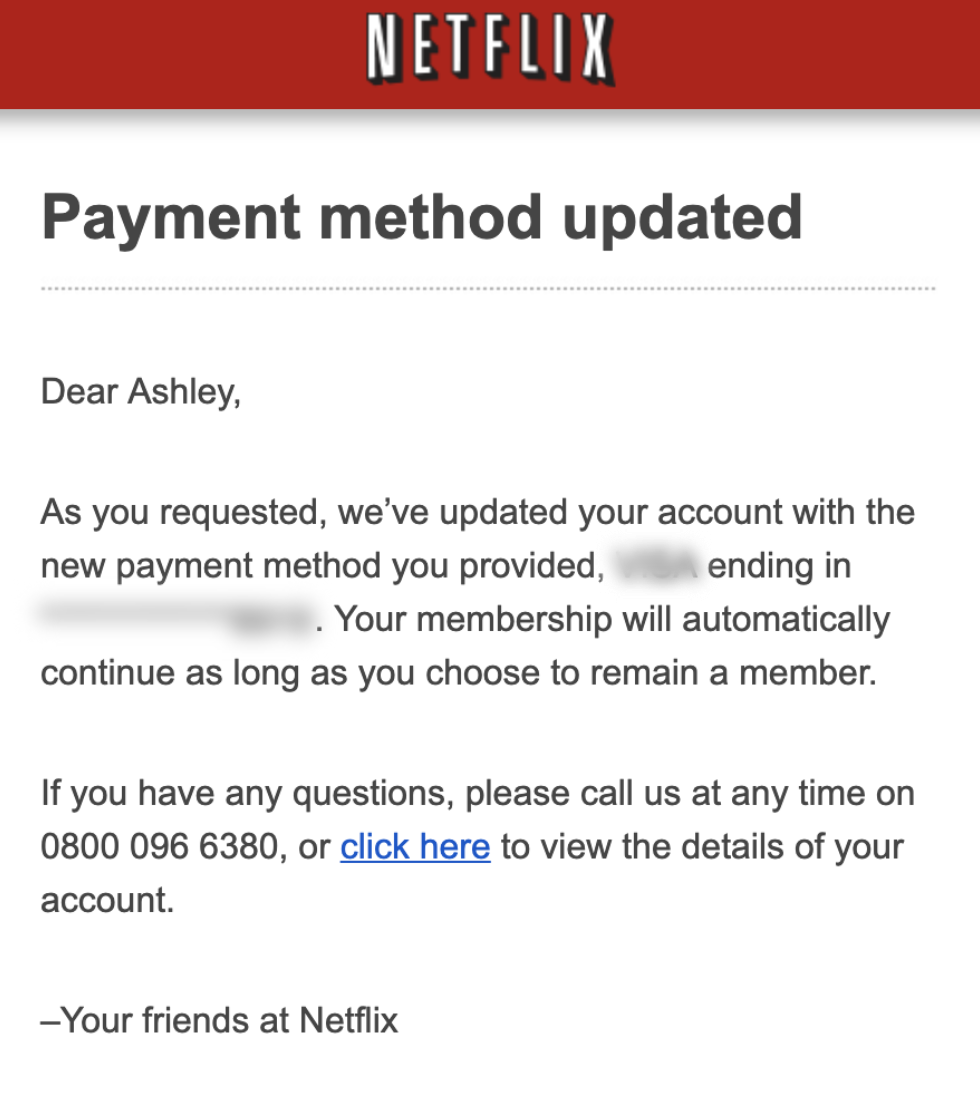
Bonus: Now that a customer’s subscription is active again, notice the CTA at the bottom of the email directing the customer to view the programs and films available on Netflix. This is a great way to re-engage the customer with the product.
The final email comes shortly after the second email to confirm that the payment has been successful. This is a great way to close the loop and reassure the customer everything is fixed on their account:
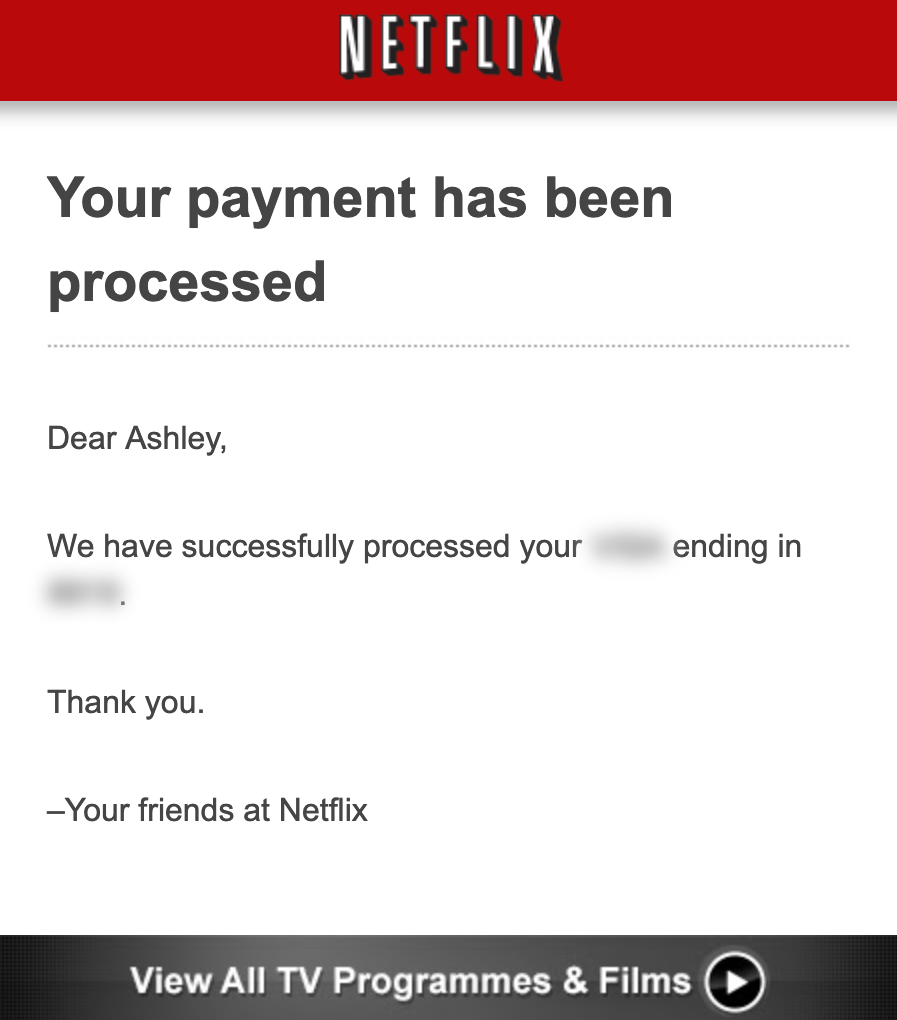
The key to these emails is clarity. To create a successful "fixing an issue" workflow you need to:
-
Clearly identify the problem.
-
Lay out simple-to-follow instructions to fix the problem.
-
Let the customer know once the problem is solved.
6. The Retargeting Workflow
Retargeting ads can be a powerful way to grow your traffic and revenues, but if you’re tracking the right data, you can also use retargeting emails to help drive your people toward making a purchase.
Take Airbnb, for example. When a logged-in user is browsing its website or app, the site gathers data on what they’re searching for and which spaces they’re looking in.
Airbnb then uses this data to enter users into a workflow based on their recent search history.
After a recent browse through the app, I received two messages about booking a stay in Toronto.
Here’s the first email, which arrived a few hours after my search:
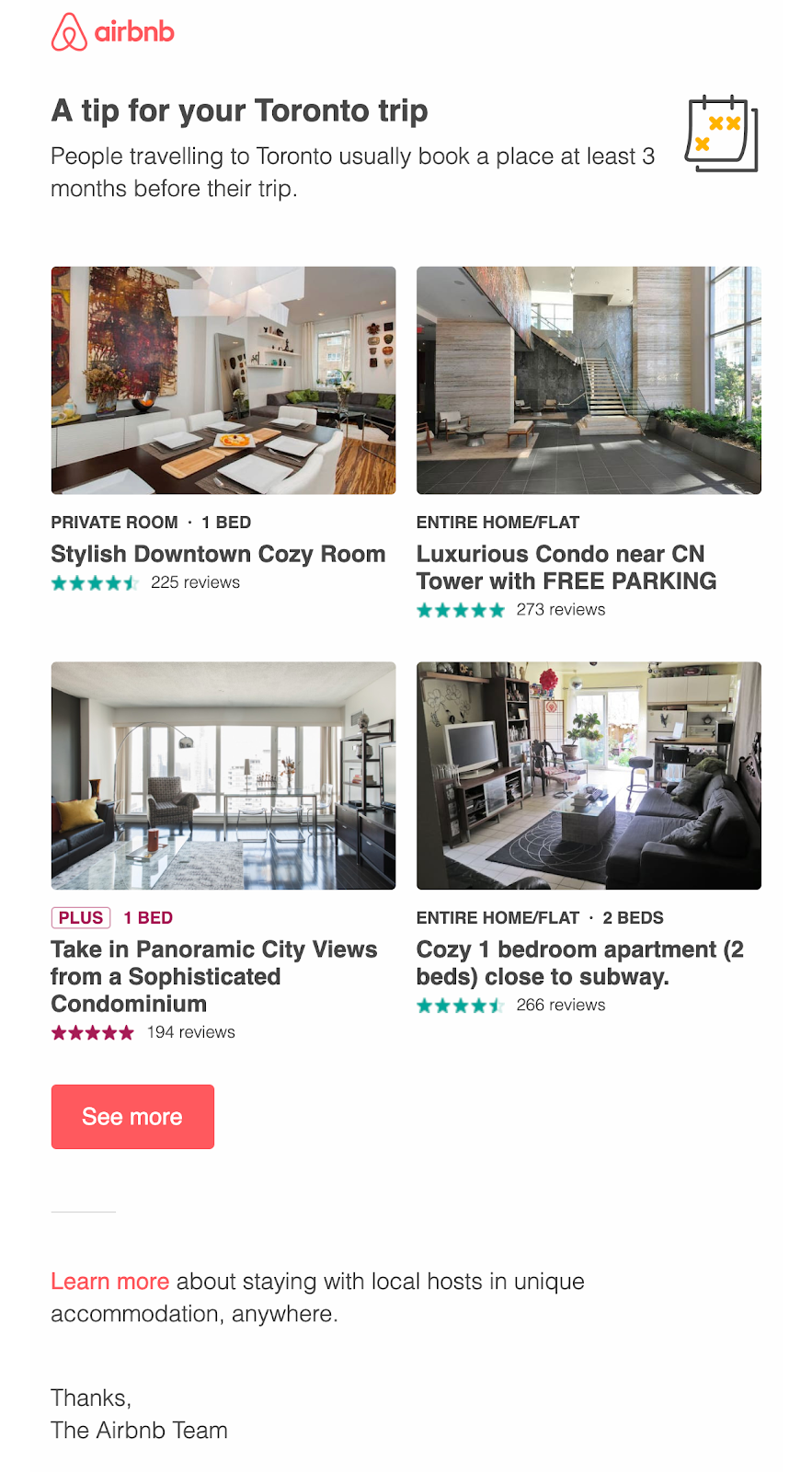
And the second email which hit my inbox around 10 days later:
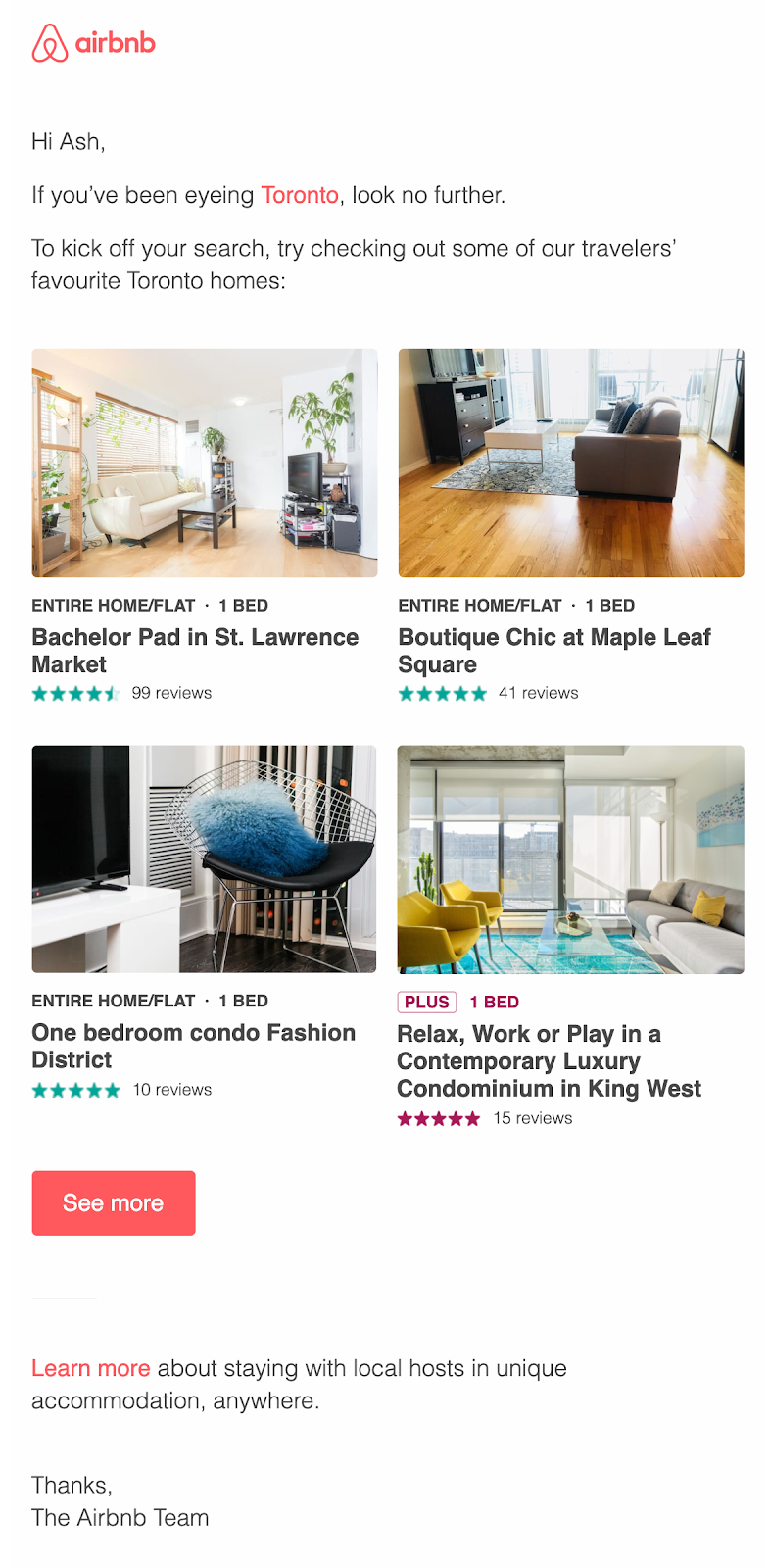
7. Reactivation Workflow
Reactivating lapsed customers or disengaged email subscribers is a great tactic to help grow your business.
Now I’m guessing you don’t have time to sit and email every lapsed customer in your database manually, so this is where an email workflow can help.
LinkedIn uses an email series to try to encourage lapsed trial users to join LinkedIn Premium.
Each of the emails it sends try to convert lapsed trials, based on the different benefits of its Premium service.
The first email of the sequence focuses on seeing who’s checking out your profile:

The second email, sent seven days later, highlights a larger range of Premium features and benefits:

And the third email of the workflow arrives another seven days later and focuses on how LinkedIn Premium can help you land your next job:
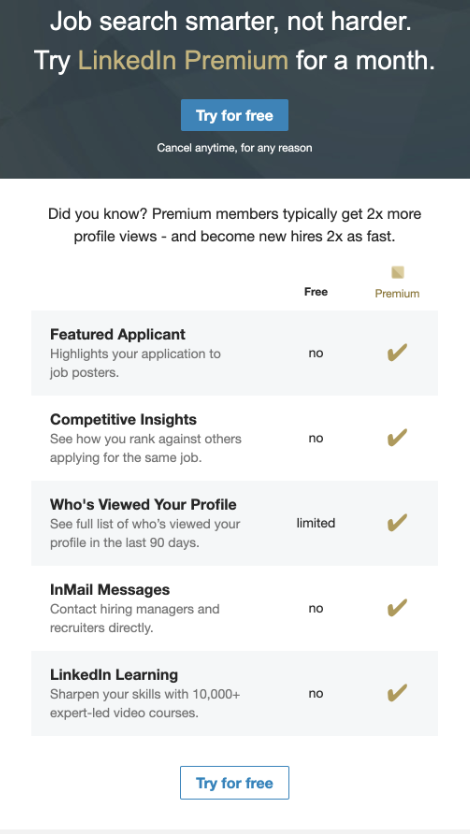
A note on frequency: LinkedIn appears to be pretty aggressive with this workflow and sends it out again to lapsed trialers each month. I find this a little overwhelming, so it might be worth thinking about how often you want to contact lapsed customers, trialers or subscribers.
8. Free Trial Conversion Workflow
When someone starts up a trial of your product, you have a short window to convince them to part with their cash.
After starting a trial with SimilarWeb, each trialer enters a workflow that starts after the "Welcome" email hits their inbox.
About 20 minutes after the "Welcome" email, I received this message (the first in the trialer series):
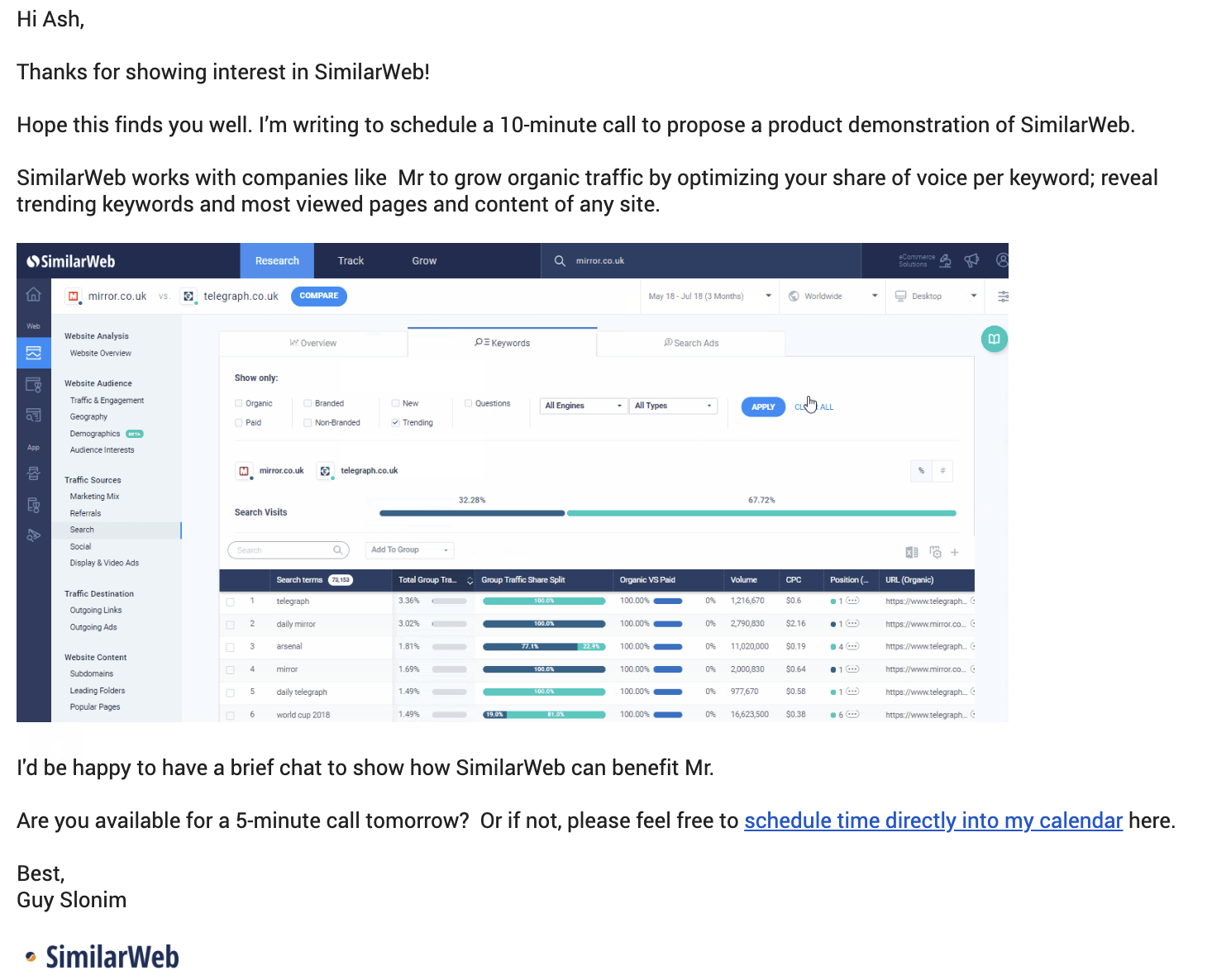
Four days later, I received a follow-up email asking if I would like to book a call:

After another four days, just as my free trial was about to expire, I received another email to organize a call:
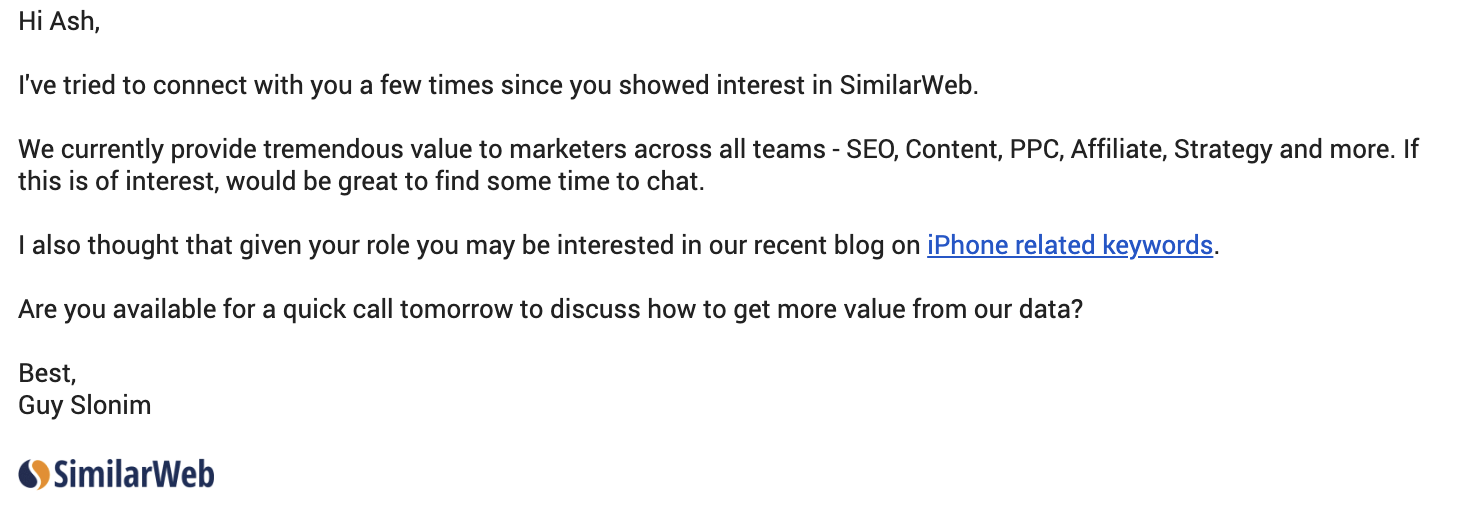
And an email letting me know my trial was about to expire:

This might seem like quite a long sequence over a 14-day period, but with higher-cost products, sometimes more touchpoints are needed.
How To Create An Email Workflow
1. Set A Goal
Any email workflow should start with a clear, measurable goal — something you can use to measure the success of the workflow.
For example, you might want to:
-
Onboard new trialers and help them convert to customers.
-
Encourage new blog subscribers to become engaged readers.
Once you have a goal in mind, think about how you will measure it:
-
Onboard new trialers and help them convert to customers: measured by conversion rates of new trialers.
-
Encourage new blog subscribers to become engaged readers: measured by open and click rates.
And now you need to set a target. So if I was working to welcome new blog subscribers, I might check open rate benchmarks to give myself a clear target to aim form.
2. Decide On A Trigger
The trigger is the action or data point that enters someone into this workflow.
For example:
-
A subscriber not opening any of your emails for 90 days [data point] might trigger a reactivation workflow.
-
A new customer signing up [action] might trigger a getting started workflow.
The trigger must be a logical step into the workflow for the recipient. For example, if someone signs up to a lead magnet, emailing them about using your product might not make much sense to them.
Carefully decide on your trigger and then plan your workflow accordingly.
3. Plan The Workflow
Next, you need to figure out the steps in your workflow. One of the best ways to do this is to sketch it out, so you can see the journey from a high level.
Here’s a look at a super simple cart abandonment workflow from AppSumo:

It’s only one email, but you can see the trigger is an action (someone not completing a check out) and the message is sent out two hours later.
When it comes to the number of emails in your workflow and the frequency, there’s no magic bullet. It will take time and testing to figure out the best solution.
Some of the examples we’ve shared today are just 1-2 emails, whereas others are 5+. My advice would be to keep it short (<5 emails), and measure your results. You can always make changes as you go.
Pro Tip: The best workflows deliver value for the user, not just your company. Think about how every email you send can deliver value on both ends. Ahrefs is a great example of this — its emails help customers to learn about SEO and its tool.
4. Implement The Workflow In Your Email Tool
With the workflow mapped out, the next step is to implement it. Most email tools have automation and workflow features, with each tool handling things a little different.
If you’re not quite sure how to get started, check out your email tool’s FAQs or Google [Tool] Workflows or [Tool] Workflow Automations.
When setting up your workflow, double (and triple) check:
-
Frequency: What’s the gap between each email? Is everything set up correctly?
-
Subject lines: Do they make sense to the customer? Are they innately clickable?
-
Order: Are you sending the right emails at the right times?
Sumo allows you to send an email workflow when a visitor joins the email list through a Sumo form. Watch this video by Chris on how to set that up:
Sumo’s Email Workflow Teardown
So there we have it. Eight great email workflow examples and how to create your own.
But that’s not it. To help you succeed with workflows at your business, we’ve created a teardown of one of Sumo’s own workflows so you can see exactly how it works.
Add A Comment
VIEW THE COMMENTS